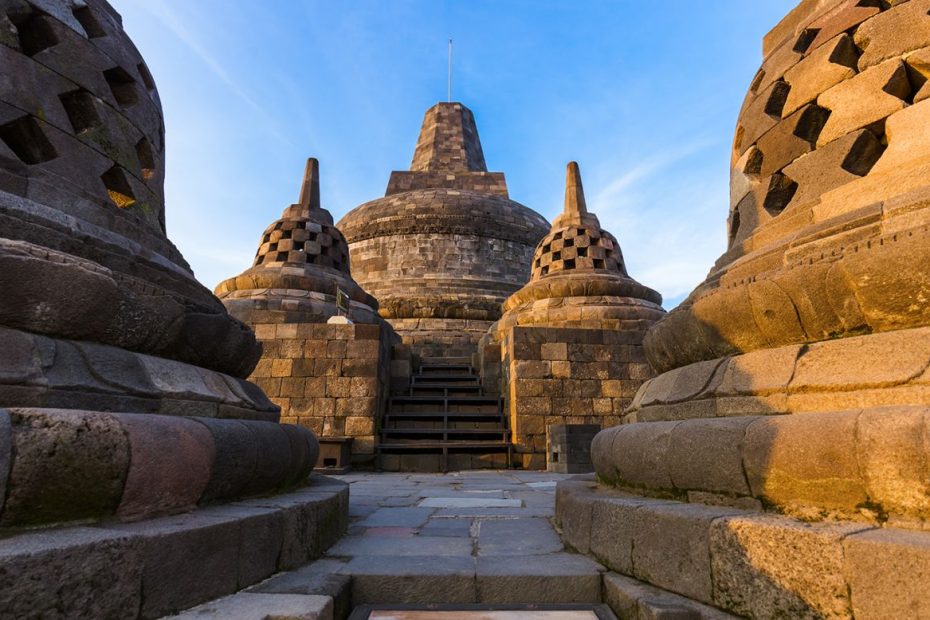Table of Contents
Introduction
Indonesia is home to some of the world’s most magnificent ancient temples that have stood strong over countless centuries. These architectural marvels provide a window into Indonesia’s rich history and culture. Exploring these sacred sites is sure to be an unforgettable experience. Let’s uncover the mysteries and grandeur of Indonesia’s awe-inspiring temples.
Borobudur Temple
Situated in Central Java, Borobudur Temple is the world’s largest Buddhist temple. Built around 800 AD during the Sailendra dynasty, this colossal temple was designed in the shape of a mandala – a square structure with concentric circular terraces. Borobudur has nine stacked platforms, topped with 72 bell-shaped stupas that are believed to contain Buddha statues.
The temple is decorated with 2,672 impressive relief panels that extend along the walls and balustrades. These detailed panels illustrate Buddhist teachings and the life story of Buddha. The sheer size and intricate details make Borobudur a stunning sight to behold. As you walk through this temple, its spiritual essence and magical energy are undeniable.
Prambanan Temple
On the island of Java lies the remarkable Prambanan Temple. As one of the largest Hindu temples in Indonesia, it contains shrines dedicated to the three great Hindu divinities – Shiva, Vishnu and Brahma. With towering spires that reach up to 47 meters high, Prambanan exudes a grand and majestic presence.
The temple has extensive carved bas-reliefs depicting famous mythological scenes from Hindu epics. The most popular Shiva temple features stone guardians at the entrance and ornate stonework on each layer. Local folklore says Prambanan was built by demons in one miraculous night. As the sun rose, the demons vanished, leaving behind an incredible work of devotion and magic.
Penataran Temple
Nestled on the slopes of Mount Kawi in East Java lies the ancient Penataran Temple. This was once one of the most powerful temples in Java that served as a mountain sanctuary dedicated to Lord Shiva. The main structure has terraced roofs in increasing sizes to represent Hindu-Buddhist cosmological symbolism.
Penataran boasts exquisite stone carvings such as the imposing faces of Kala, the god of time. Multiple courtyards, altars and sitting areas reflect the layout for religious activities and ceremonies. One unique feature is the Palguna stones, which align with the mid-year sunrise – quite an astronomical feat for ancient Javanese engineers!
Pura Ulun Danu Bratan
For a temple bounded by natural beauty, head to Pura Ulun Danu Bratan in Bali. Surrounded by lush forests and situated next to Lake Bratan, this water temple is dedicated to Dewi Danu, the goddess of water. With its pagoda-style towers, ornate gates and expansive courtyards, Ulun Danu makes for a postcard-perfect scene with the misty lake as its backdrop.
More than just picturesque, Ulun Danu holds significant religious meaning for the Balinese people. Its water source supports irrigation and agriculture for surrounding areas. During festivals and ceremonies, locals flock to the temple to pay homage to Dewi Danu who protects the life-giving water.
Candi Sewu Temple
With over 240 temples in one complex, Candi Sewu is the second largest Buddhist temple compound in Indonesia. Located near Prambanan, this 8th century temple displays a blend of Buddhist and Hindu architecture. The name Sewu translates to ‘thousand temples’ which conveys how massive this religious complex is.
As you wander through rows of temples, it’s easy to get lost amidst the grandeur. Dozens of Buddha statues line the walkways, set against a backdrop of lush greenery. The centerpiece Perwara temple will capture your attention with its detailed carvings. Prepare to be awestruck by this sanctuary of incredible ruins.
Conclusion
From enormous Buddhist stupas to towering Hindu spires, Indonesia’s ancient temples are architectural marvels that offer insight into forgotten civilizations. Beyond their physical beauty and scale, these sacred sites reveal the ingenuity, values and spirituality that shaped Indonesia’s heritage. Immersing yourself in the wonder and mysteries of these archaeological treasures is an experience you will cherish forever. Their enduring legacies remind us of the astonishing feats human hands can achieve.
FAQs
FAQ 1: What are some similarities between the temples?
The temples often share architectural features like terraces, courtyards, and ornate stone carvings. Many were built between the 8th-10th centuries during Hindu-Buddhist kingdoms. Their layouts reflect Indonesian cosmology and design principles.
FAQ 2: Which temple do locals most revere?
Pura Ulun Danu Bratan holds special significance for Balinese locals as it supports their irrigation and rice agriculture. They deeply revere Dewi Danu, the water goddess worshipped there.
FAQ 3: How were these enormous temples constructed?
It remains a mystery! The technology and manpower required to quarry, transport and precisely carve the stonework is impressive for ancient times.
FAQ 4: What is the best time of year to visit?
Dry season between April-October offers ideal weather. But visits during monsoon season allow you to see the temples enveloped in mist.
FAQ 5: What threats do the temples face today?
Age, weathering, volcanic eruptions, and earthquakes damage structures over time. But human-caused threats like urbanization, pollution, and unmanaged tourism also jeopardize these icons of heritage.
